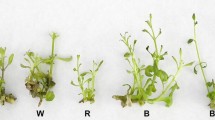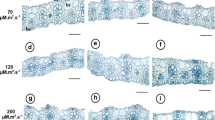Abstract
A study of the effect of various light intensity (75, 135, 230, and 382 µmol/(m2 s)) on the morphogenesis of Stevia rebaudiana (Bertoni) Bertoni in vitro was carried out using a unique LED light source Sun Box (wavelength range of 440–660 nm) developed at the Institute of Automation and Control Processes (Far East Branch, Russian Academy of Sciences). The light spectrum of the Sun Box was close to the solar spectrum. Luminescent light with an intensity of 49 µmol/(m2 s) was used as a control. It was shown that the cultivation of plantlets using an LED source with an intensity of 75 and 230 µmol/(m2 s) promoted the development of plantlets with a combination of morphological and mesostructural parameters important for microclonal reproduction and/or adaptation to the ground. Such plantlets accumulated the maximal weight of the aerial parts and roots, which was especially important for their subsequent transfer into open ground conditions. Plantlets cultivated at a given light intensity with a developed root system would pass the adaptation process faster and it, in turn, would reduce the percentage of plant mortality. The use of a composite LED light source with a certain intensity during in vitro cultivation of S. rebaudiana would allow optimization of the growing and propagation of plantlets and would reduce energy costs compared with the use of fluorescent lamps.




Similar content being viewed by others
REFERENCES
Soejarto, D.D., Douglas, K., and Farnsworth, N.R., Potential sweetening agents of plant origin-III. Organoleptic evaluation of Stevia leaf herbarium samples for sweetness, J. Nat. Prod., 1982, vol. 45, pp. 590–599.
Kinghorn, A.D., Soejarto, N.P.D., and Nanayakkara, C.M., A phytochemical screening procedure for sweet entkaurene glycosides in the genus Stevia, J. Nat. Prod., 1984, vol. 47, pp. 439–444.
Melis, M.S., Renal excretion of stevioside in rats, J. Nat. Prod., 1992, vol. 55, pp. 688–690.
Valio, I.F.M. and Rocha, R.F., Effect of photoperiod and growth regulator on growth and flowering of Stevia rebaudiana Bertoni, Jpn. J. Crop Sci., 1977, vol. 46, pp. 243–248.
Jeppesen, P.B., Gregersen, S., and Poulsen, C.R., Stevioside acts directly on pancreatic beta cells to secrete insulin: actions independent of cyclic adenosine monophosphate- and adenosine triphosphate-sensitive K+-channel activity, Metabolism, 2000, vol. 49, pp. 208–214.
Curi, R., Alvarez, M., and Bazotte, R.B., Effect of Stevia rebaudiana on glucose tolerance in normal adult humans, Braz. J. Med. Biol. Res., 1986, vol. 19, pp. 771–774.
Pederson, P., Approximate composition of Stevia rebaudiana Bertoni, Nutr. Herbol., 1987, vol. 18, pp. 377–380.
Goyal, S.K. and Goyal, R.K., Stevia (Stevia rebaudiana) a bio-sweetener: a review, Int. J. Food Sci. Nutr., 2010, vol. 61, pp. 1–10. https://doi.org/10.3109/09637480903193049
Mitra, A. and Pal, A., In vitro regeneration of Stevia rebaudiana (Bert.) from nodal explants, J. Plant Biochem. Biotechnol., 2007, vol. 16, pp. 59–62.
Abdullateef, R.A. and Osman, M.B., Effects of visible light wavelengths on seed germinability in Stevia rebaudiana Bertoni, Int. J. Biol., 2011, vol. 3, pp. 83–91.
Ramírez-Mosqueda, M.A., Iglesias-Andreu, L.G., and Bautista-Aguilar, J.R., The effect of light quality on growth and development of in vitro plantlet of Stevia rebaudiana Bertoni, Sugar Tech., 2017, vol. 19, pp. 331–336.
Zaidan, L.B., Dietrich, S.M., and Felippe, G.M., Effect of photoperiod on flowering and stevioside content in plants of Stevia rebaudiana Bertoni, Jpn. J. Crop Sci., 1980, vol. 49, pp. 569–574.
Ceunen, S., Werbrouck, S., and Geuns, J.M., Stimulation of steviol glycoside accumulation in Stevia rebaudiana by red LED light, J. Plant Physiol., 2012, vol. 169, pp. 749–752.
Bondarev, N.I., Reshetnyak, O.V., and Nosov, A.M., Influence of the spectral composition of visible light and ultraviolet radiation on the development of Stevia rebaudiana Bertoni plants in vitro and biosynthesis of steviol glycosides, Uch. Zap. Orlov. Gos. Univ., Ser. Estest. Tekhnich. Med. Nauki, 2010, vol. 4, pp. 55–62.
Evans, J.M., Vallejo, V.A., Beaudry, R.M., and Warner, R.M., Daily light integral influences steviol glycoside biosynthesis and relative abundance of specific glycosides in Stevia, HortScience, 2015, vol. 50, pp. 1479–1485.
Ermakov, E.I. and Kochetov, A.A., Stevia rebaudiana Bertoni plant growth and productivity in controlled conditions depending on photoperiod and light intensity, Dokl. Ross. Akad. S-kh. Nauk, 1994, no. 6, pp. 7–8.
Gogichaishvili, N.E., Accumulation of dry above-ground mass and sweet glycosides in Stevia rebaudiana Bertoni plants on different light modes in regulated conditions, IV Mezhd. konf. “Selektsiya, ekologiya, tekhnologiya vozdelyvaniya i pererabotka netraditsionnykh rastenii” (Proc. IV Int. Conf. “Selection, Ecology, Cultivation, and Processing of Untraditional Plants”), Simferopol’, 1996, pp. 94–96.
Bondarev, N.I., Reshetnyak, O.V., and Nosov, A.M., Influence of photoperiod and irradiation intensity on the development of Stevia rebaudiana shoots in vitro and synthesis of steviol glycosides, Izv. TSKhA, 2008, no. 4, pp. 102–107.
Murashige, T. and Skoog, F., A revised medium for rapid growth and bio-assays with tobacco tissue cultures, Physiol. Plant., 1962, vol. 15, pp. 473–497.
Khrolenko, Yu.A., Burundukova, O.L., Burkovskaya, E.V., and Zhuravlev, Yu.N., Mesophyll structure and chloroplast density in Panax ginseng leaves from the Sikhote-Alin Mts, Acta Biol. Cracov., Ser. Bot., 2012, vol. 54, pp. 54–60.
Goryshina, T.K., Fotosinteticheskii apparat rastenii i usloviya sredy (Photosynthetic Apparatus of Plants and Environment Conditions), Leningrad: Leningrad Gos. Univ., 1989.
Nobel, P.S., Zaragoza, G.J., and Smith, W.K., Relation between mesophyll surface area, photosynthetic and illumination level during development for the leaves of Plectranus parviflorus Henckel, Plant Physiol., 1975, vol. 55, pp. 1067–1070.
Tsel'niker, Yu.L., Fiziologicheskie osnovy tenevynoslivosti drevesnykh rastenii (Physiological Basis for the Shade Tolerance of Woody Plants), Moscow: Nauka, 1978.
Mokronosov, A.T., Mesostructure and functional activity of photosynthetic apparatus, in Mezostruktura i funktsional’naya aktivnost' fotosinteticheskogo apparata (Mesostructure and Functional Activity of Photosynthetic Apparatus), Sverdlovsk: Ural. Gos. Univ., 1978, pp. 5–30.
Mokronosov, A.T., Ontogeneticheskii aspekt fotosinteza (The Ontogenetic Aspect of Photosynthesis), Moscow: Nauka, 1981.
Zalenskii, V.R., Materials on quantitative anatomy of different leaves of the same plants, Izv. Kiev Politekh. Inst., 1904, vol. 4, pp. 1–12.
Singh, T.C.N., An anatomical and ecological study of some ferns from Mussoorie (North + Western Himalayas), J. Ind. Bot. Soc., 1963, vol. 42, pp. 475–544.
Vogelmann, T.C., Plant tissue optics, Annu. Rev. Plant Physiol. Mol. Biol., 1993, vol. 44, pp. 231–251.
Burkovskaya, E.V., Mesostructure of the Mertensia maritima (L.) S.F. Gray plant photosynthetic apparatus at different latitudes of the Russian Far East, Vestn. Krasnoyarsk Gos. Agrar. Univ., 2009, no. 10, pp. 50–53.
Vakhrusheva, D.V., Mesostructure of photosynthetic apparatus in C3-plants from the arid zone of Central Asia, Extended Abstract of Cand. Sci. (Biol.) Dissertation, Leningrad, 1989.
ACKNOWLEDGMENTS
We are grateful to Lydia Mikhailovna Timasheva, Lead Engineer of the Biotechnology Lab (Federal Scientific Center of the East Asia Terrestrial Biodiversity, Far East Branch, Russian Academy of Sciences) for providing S. rebaudiana plantlets for microclonal propagation.
Funding
The study was supported by a grant of the Far East Branch of the Russian Academy of Sciences (Far East no. 18-5-079).
Author information
Authors and Affiliations
Corresponding author
Ethics declarations
The authors declare that they have no conflict of interest. This article does not contain any studies involving animals or human participants performed by any of the authors.
Additional information
Translated by V. Mittova
Abbreviations: CVC—cell volume per chloroplast; LEDs—light emitting diodes.
Rights and permissions
About this article
Cite this article
Nakonechnaya, O.V., Gafitskaya, I.V., Burkovskaya, E.V. et al. Effect of Light Intensity on the Morphogenesis of Stevia rebaudiana under In Vitro Conditions. Russ J Plant Physiol 66, 656–663 (2019). https://doi.org/10.1134/S1021443719040095
Received:
Revised:
Accepted:
Published:
Issue Date:
DOI: https://doi.org/10.1134/S1021443719040095




